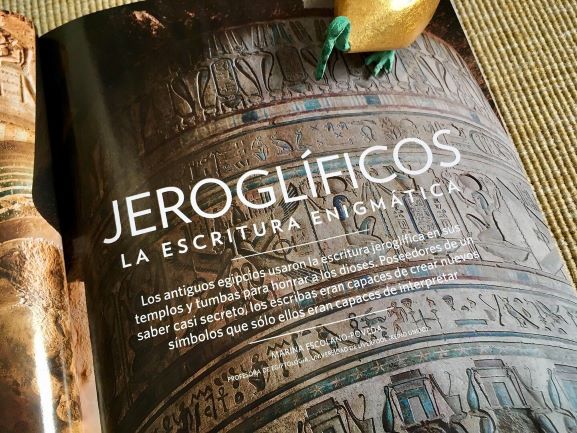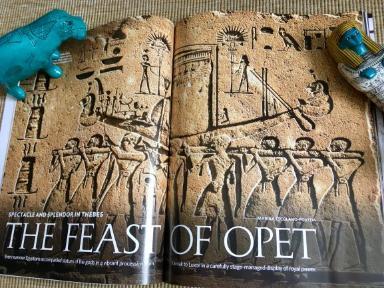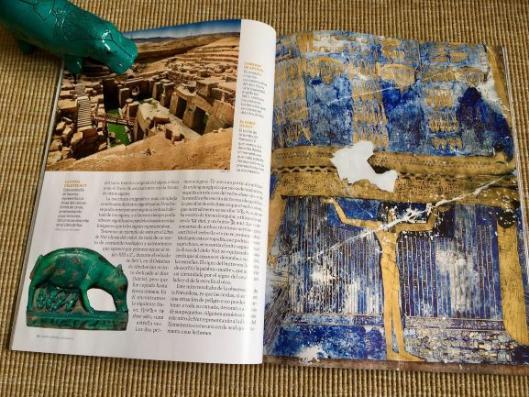
When I was a little girl, my mother used to take me to the local library every week after school to look at books and magazines, and pick up new reads for the weekend. It was in those early bookish explorations how I first became fascinated by the Ancient World, and particularly by Egypt and her mysterious hieroglyphic script. I remember specifically one special issue of National Geographic that was devoted entirely to Ancient Egypt, with a wealth of photographs and illustrations that transported me several millennia back into the past. This magazine kindled a spark that developed over the years into a burning passion for Egyptology, which would in the end become my chosen career path.
Some decades later, while I was busy working on my third year of doctoral studies, I received an email that brought those childhood memories back from the past. It was from National Geographic. With anticipation, I clicked on it and read it quickly. They had heard about my lectures on Egyptian topics for the general public, and wanted to commission me with an article about ancient Egyptian hieroglyphs for the Spanish branch of their magazine on historical and archaeological topics, National Geographic History. Delighted, I undertook the task. I hoped that with my explanations, which included an easy guide to read basic hieroglyphic inscriptions, more kids would fall in love with this fascinating ancient culture. After that initial collaboration, I am now one of their recurring authors on topics about Ancient Egypt.

A few months ago I was contacted once again by National Geographic to write on a topic that I had suggested to them some time ago: Egyptian cryptography. The ancient Egyptians were fully aware of the possibilities that the iconicity of their hieroglyphic script offered, and soon started playing with different orthographies in order to convey different layers of meaning, especially in religious texts. In my article, which is currently available in the Spanish issue of National Geographic History (June 2019), I show some examples of this, such as the following: the writing of a common phrase like “given life like (the Sun god) Ra”, used after the names of pharaohs, was normally written with this string of signs: ![]() di ankh mi ra. However, this sentence could also be written with the following monogram:
di ankh mi ra. However, this sentence could also be written with the following monogram: ![]() This monogram is composed by a cat holding an ankh-sign, meaning life. The action of holding the ankh-sign with the cat’s paw represents the verb “to give”, normally written with a stretched arm offering a triangular piece of bread
This monogram is composed by a cat holding an ankh-sign, meaning life. The action of holding the ankh-sign with the cat’s paw represents the verb “to give”, normally written with a stretched arm offering a triangular piece of bread ![]() , or just by the piece of bread
, or just by the piece of bread ![]() , as noted above. The cat was pronounced similarly to the preposition
, as noted above. The cat was pronounced similarly to the preposition ![]() “like”, mi, and thus the normal sign for the preposition was replaced by the cat sign in the monogram. Interestingly enough, the name of the cat in ancient Egyptian, miw, reflects the sound this animal makes. Finally, the sign used to write the name of Ra, a sun disk, appears on the head of the cat. This monogram adds an extra nuance to the sentence, alluding to the form of the Sun god Ra as the solar cat of Heliopolis defeating his enemy, the serpent Apophis.
“like”, mi, and thus the normal sign for the preposition was replaced by the cat sign in the monogram. Interestingly enough, the name of the cat in ancient Egyptian, miw, reflects the sound this animal makes. Finally, the sign used to write the name of Ra, a sun disk, appears on the head of the cat. This monogram adds an extra nuance to the sentence, alluding to the form of the Sun god Ra as the solar cat of Heliopolis defeating his enemy, the serpent Apophis.
As this article was being prepared for publication, I was informed that a previous article I had written for the magazine had been translated into English, and it appears in the May/June 2019 issues of National Geographic History in both the United Kingdom and the United States. This article is about the Opet Festival, a magnificent religious celebration that took place annually in the ancient capital of Thebes, and that has survived until the present as a local Muslim feast in modern Luxor.
